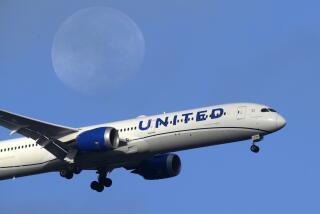Coming soon: Airline Wi-Fi that actually works
- Share via
Air travel and glitch-free internet access are often considered mutually exclusive, thanks to the technical difficulties associated with making Wi-Fi work at 40,000 feet.
For the airlines, a satisfying online experience is even more elusive. The hardware, software, maintenance and inability to easily switch service providers combine for a very expensive headache.
But there may be some good news on the horizon — a new era of ground-quality internet connectivity that could save carriers billions of dollars. The Seamless Air Alliance, a nonprofit group of 30 companies, says its new tech architecture will make in-flight connectivity systems modular, with open interfaces and components that can easily be swapped out.
The alliance includes Airbus and Delta Air Lines Inc., with such equipment makers and satellite companies as Panasonic Avionics, Intelsat, Nokia Oyj and Vodafone Group. Together, they want to introduce a global standard, using protocols derived from the cellular and Wi-Fi industries.
Jack Mandala, the alliance’s chief executive, said that airlines now “have equipment that only works with the provider they’ve chosen.” Universal adoption of the framework, he predicted, could change that.
Elon Musk and SpaceX have staked their legacy on a spaceship capable of carrying a hundred passengers to Mars.
For passengers, this alliance may change the entire airport experience. Your mobile connection would migrate from one system to another, from the terminal onto the jet bridge and down the aisle to your seat — without the need to log in or pay. No longer would you be restricted to airline movies you’ve already seen, television episodes you’ve already skipped or video games you never wanted to play.
“Today, that experience can be a brand-damaging event for the airline,” Mandala said of onboard internet access. “Passengers are out there on social media, complaining when they can’t get service, and they don’t blame the service provider — they blame the airline.”
He said new internet companies will enter the market, attracted by the unified standards. This will boost competition and quality in an industry that often enrages travelers. “For inflight connectivity,” he said, “the high cost of capacity has been the Achilles heel.”
These new protocols might also save airlines billions of dollars, allowing for “rapid adoption of new technologies in a surgical manner,” the group said Tuesday in a statement. This means that airlines would be able to manage their Wi-Fi offerings more efficiently, easily changing providers as a new generation of low-Earth-orbit satellite networks come online. These could include offerings from Elon Musk’s Starlink; Softbank Group Corp.-backed OneWeb; and Amazon.com’s Project Kuiper.
A 5% improvement in these areas — based on an analysis conducted over 10 years, with a fleet of 10,000 internet-connected aircraft increasing to 25,500 by 2028 — would boost the value of the in-flight connectivity market by $11.4 billion, according to a 2019 white paper the alliance commissioned. This would increase to almost $37 billion if customer use rates were to double, along with a 5% improvement in the three other metrics, the study found.
Before you start dreaming of bandwidth, however, here’s a buzzkill: Plenty of key industry players have yet to get involved — including American Airlines Group Inc., Boeing Co., Gogo Inc., and Verizon Communications Inc. Still, Mandala contends that it’s only a matter of time before the industry coalesces around standards that lower costs for airlines.
To become compliant with the standards, most equipment makers will need to modify software, something Mandala, a former Qualcomm Inc. executive, contends is “not a big deal,” financially.
“There are market forces at work that are ready to drive down costs, given the capacity that’s coming online,” he said. “Going to these standards will knock down these artificial barriers that’s holding back this big growth in the market.”
Among them: high prices, spotty service caused by bandwidth bottlenecks, the dodgy nature of typing in your credit-card number with a snoopy seatmate 5 inches away, and the general milieu of glitch behavior encountered when trying to connect on different networks with different devices.
On those flights that offer Wi-Fi access, this friction-filled scenario leaves customer purchase rates well below 10%. Most passengers simply connect to the streaming entertainment delivered wirelessly from servers on the plane. A few even engage in that old-fashioned hobby called reading.
More to Read
Inside the business of entertainment
The Wide Shot brings you news, analysis and insights on everything from streaming wars to production — and what it all means for the future.
You may occasionally receive promotional content from the Los Angeles Times.










